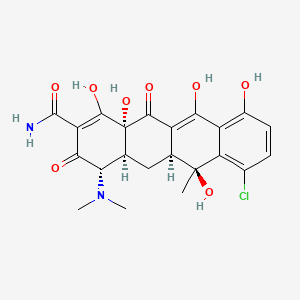| MeSH term | MeSH ID | Detail |
|---|---|---|
| Mycoplasma Infections | D009175 | 13 associated lipids |
| Tooth, Impacted | D014095 | 9 associated lipids |
| Salmonella Food Poisoning | D012478 | 2 associated lipids |
| Treponemal Infections | D014211 | 3 associated lipids |
| Dysentery | D004403 | 4 associated lipids |
| Anaplasmosis | D000712 | 3 associated lipids |
| Granuloma, Giant Cell | D006101 | 7 associated lipids |
| Theileriasis | D013801 | 7 associated lipids |
| Urethritis | D014526 | 9 associated lipids |
| Syphilis, Latent | D013592 | 4 associated lipids |
chlortetracycline
chlortetracycline is a lipid of Polyketides (PK) class. Chlortetracycline is associated with abnormalities such as Granulomatous Disease, Chronic, Infection, Ischemia, Cerebral Ischemia and Cerebral Infarction. The involved functions are known as Regulation, Binding (Molecular Function), Agent, Stimulus and Process. Chlortetracycline often locates in Protoplasm, Plasma membrane, Membrane, Cytoplasm and specific granule. The associated genes with chlortetracycline are FPR1 gene, P4HTM gene, Homologous Gene, HIST1H1C gene and Microbiome. The related lipids are Lysophosphatidylcholines, Sterols, dilauroyl lecithin, seminolipid and Total cholesterol. The related experimental models are Mouse Model.
Cross Reference
Introduction
To understand associated biological information of chlortetracycline, we collected biological information of abnormalities, associated pathways, cellular/molecular locations, biological functions, related genes/proteins, lipids and common seen animal/experimental models with organized paragraphs from literatures.
What diseases are associated with chlortetracycline?
chlortetracycline is suspected in Ischemia, Cerebral Ischemia, Cerebral Infarction, Granulomatous Disease, Chronic, Infection, Antibiotic resistant infection and other diseases in descending order of the highest number of associated sentences.
Related references are mostly published in these journals:
| Disease | Cross reference | Weighted score | Related literature |
|---|
Possible diseases from mapped MeSH terms on references
We collected disease MeSH terms mapped to the references associated with chlortetracycline
PubChem Associated disorders and diseases
What pathways are associated with chlortetracycline
There are no associated biomedical information in the current reference collection.
PubChem Biomolecular Interactions and Pathways
Link to PubChem Biomolecular Interactions and PathwaysWhat cellular locations are associated with chlortetracycline?
Visualization in cellular structure
Associated locations are in red color. Not associated locations are in black.
Related references are published most in these journals:
| Location | Cross reference | Weighted score | Related literatures |
|---|
What functions are associated with chlortetracycline?
Related references are published most in these journals:
| Function | Cross reference | Weighted score | Related literatures |
|---|
What lipids are associated with chlortetracycline?
Related references are published most in these journals:
| Lipid concept | Cross reference | Weighted score | Related literatures |
|---|
What genes are associated with chlortetracycline?
Related references are published most in these journals:
| Gene | Cross reference | Weighted score | Related literatures |
|---|
What common seen animal models are associated with chlortetracycline?
Mouse Model
Mouse Model are used in the study 'Chlortetracycline and demeclocycline inhibit calpains and protect mouse neurons against glutamate toxicity and cerebral ischemia.' (Jiang SX et al., 2005).
Related references are published most in these journals:
| Model | Cross reference | Weighted score | Related literatures |
|---|
NCBI Entrez Crosslinks
All references with chlortetracycline
Download all related citations| Authors | Title | Published | Journal | PubMed Link |
|---|---|---|---|---|
| Popova GO et al. | [Effect of several antibiotics and their combination with prodigiozan on Y. pestis EV, engulfed by macrophages]. | 1977 | Antibiotiki | pmid:883789 |
| Sbracia M et al. | Sperm function and choice of preparation media: comparison of Percoll and Accudenz discontinuous density gradients. | 1996 Jan-Feb | J. Androl. | pmid:8833742 |
| Hathaway MR et al. | Serum insulin-like growth factor I (IGF-I) concentrations are increased in pigs fed antimicrobials. | 1996 | J. Anim. Sci. | pmid:8818798 |
| Heyden YV et al. | Ruggedness tests on the high performance liquid chromatography assay of the United States Pharmacopoeia 23 for tetracycline.HCl: comparison of different columns in an interlaboratory approach. | 1996 | J Pharm Biomed Anal | pmid:8818050 |
| Le Grand A and Kobisch M | [Comparison of the use of a vaccine and sequential antibiotic treatment in a herd infected with Mycoplasma hyopneumoniae]. | 1996 | Vet. Res. | pmid:8767886 |
| Korsrud GO et al. | Residue depletion in tissues and fluids from swine fed sulfamethazine, chlortetracycline and penicillin G in combination. | 1996 | Food Addit Contam | pmid:8718743 |
| Olson LD | Comparison of low-level rofenaid, low-level chlortetracycline, and vaccination with commercial bacterin for preventing pulmonary form of fowl cholera in turkeys. | 1977 Apr-Jun | Avian Dis. | pmid:869823 |
| Fraser LR et al. | Fertilization--calcium-dependent events. | 1996 | Fertil. Steril. | pmid:8641514 |
| Trostle SS et al. | Use of antimicrobial-impregnated polymethyl methacrylate beads for treatment of chronic, refractory septic arthritis and osteomyelitis of the digit in a bull. | 1996 | J. Am. Vet. Med. Assoc. | pmid:8575974 |
| Matsushita S and Suzuki E | Prevention and treatment of cilia-associated respiratory bacillus in mice by use of antibiotics. | 1995 | Lab. Anim. Sci. | pmid:8569147 |
